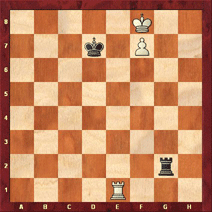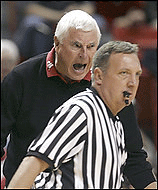I had another helpful lesson with my chess coach (
Jonathan Schroer) tonight. We went over the games from
last weekend's tourament.
In the first game, his biggest concern was with this position (black (me) to move):

Here I played Qxc6. I didn't even seriously consider Bxe3, but he had no doubts. After Bxe3, the requisite fxe3 saddles white with isolated doubled pawns on the e-file. Not only that, but doubled isolated pawns on a
half open e-file, creating a natural line of attack. He said that this is such an obvious move that I should focus on pawn structure for the next week, reading up on it in Wolff's
Idiot's Guide and (this will make Patrick happy), the book
Chess College: Pawn Play, which focuses on pawn play in the context of annotated games.
He then went into about a half-hour mini-lecture on pawn structure, constructing a heirarchy of pawn weaknesses. From doubled isolated pawns on half-open files down to backwards and doubled pawns. He says he doesn't call doubled pawns a weakness, but a
passivity, because it depends so much on the position whether the stuck pawn is actually detrimental to the position (e.g., it could cover a nice center square). However, it is not mobile which often becomes a weakenss. This lecture portion had some helpful bits, but it was a bit fast and abstract for me: I've read most of this stuff in Pandolfini's book. But, then again, it obviously hasn't set into my mind enough, or I would have played Bxe3! (Incidentally, I asked if he ever played Wolff, and he has twice: he said he took an awful beating (as white) both times).
We next went over my second game. He homed in on the following position:

For him (and Fritz), f5! was an obvious good move. If black plays exf5, black has helped open a nice line for my white bishop, and my f rook is now on a half-open file, and my black bishop also lies on an open diagonal.
While I often end up with a nice pawn structure like in the above diagram, with a pawn duo in the center, I tend to leave the pawns there until a direct threat forces me to move or until the endgame begins. I basically never push pawns. He wants me to consider pawn pushes more often, as it is the pawn structure that largely determines the activity of my pieces, and a push which will radically increase such activity needs to be made when the iron is hot.
I told him that I am not good at calculating all the variations out, especially with these pawn pushes that will radically transform the board's terrain. Hence I tend to make moves that I can visualize better. He said that I don't always need to calculate everything out. To help evaluate pawn push effects on piece activity, Nimzovich's concept of
overprotection often provides useful hints. In the present position, my f pawn is overprotected: my queen, black bishop, and (indirectly) my f-rook are all defending it. While I have always thought that the point of overprotection is to maintain the safety of a square or pawn, that is only a small part of the story. In this case, the fact that it is overprotected also implies that if I push it forward, a great deal of potential will be unleashed, as the long-range pieces being blocked by the overprotected pawn will suddenly have a surge in activity. He stressed that when I look at the board, I should visualize my pieces' movements extending
through the pawns to other squares to which they could traverse if that pawn were not there. It seems this will be very useful in helping me to figure out when to move my damned pawns!
I found this discussion very enlightening and helpful. In both games, the main critiques (besides missing a tactic here or there) were focused on pawn structure evaluation, so he has given me another negative to turn around!
Before I left, I told him I didn't like my two-knight's defense as black, and he told me how to fix it. He thinks I am plenty strong in the opening, though, and doesn't want me to work on it too much. That's a relief!
















